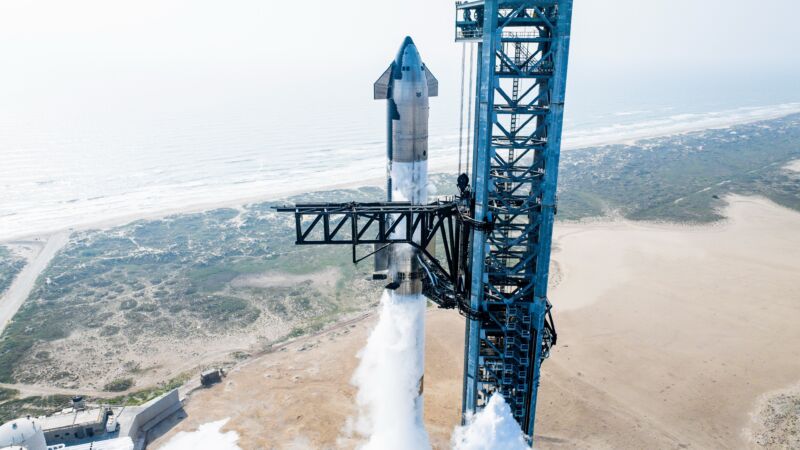IFT-4 on June 5 —
Clearing blocked filters and clogged valves is the order of the day.

Enlarge / SpaceX’s Starship vehicle undergoes a wet dress rehearsal prior to its fourth launch attempt.
SpaceX
SpaceX is targeting June 5 for the next flight of its massive Starship rocket, the company said Friday.
The highly anticipated test flight— the fourth in a program to bring Starship to operational readiness and make progress toward its eventual reuse—will seek to demonstrate the ability of the Super Heavy first stage to make a soft landing in the Gulf of Mexico and for the Starship upper stage to make a controlled reentry through Earth’s atmosphere before it falls into the Indian Ocean.
This mission will carry no payloads as SpaceX seeks additional flight data about the performance of the complex Starship vehicle. It is simultaneously the largest and most powerful rocket ever built and the first launch system ever intended to be fully and rapidly reusable.
As part of its announcement of the flight date, SpaceX provided some information about its learnings from the most recent flight test, Flight 3, which launched on March 14, 2024.
Dissecting Flight 3
During that flight, SpaceX also attempted a soft landing of the Super Heavy first stage. After its separation from the Starship upper stage, as intended, 13 of Super Heavy’s 33 Raptor engines successfully relit to make a controlled flight through the lower atmosphere. During this boostback burn, however, six of these engines shut down early. Later in the descent, as the rocket neared the sea surface, the rocket was supposed to use the same 13 engines to make a final landing burn.
“The six engines that shut down early in the boostback burn were disabled from attempting the landing burn startup, leaving seven engines commanded to start up with two successfully reaching mainstage ignition,” the company said in its recap of the flight. “The booster had lower than expected landing burn thrust when contact was lost at approximately 462 meters in altitude over the Gulf of Mexico and just under seven minutes into the mission.”
The cause of this failure was traced to blockage in a filter where liquid oxygen flows into the Raptor engines. Notably, a similar problem occurred during the second test flight of Starship in November 2023. SpaceX says it implemented “hardware changes” to address this blockage issue for the third test flight. Now, the company said, “Super Heavy boosters for Flight 4 and beyond will get additional hardware inside oxygen tanks to further improve propellant filtration capabilities.” It will be interesting to see whether the company’s engineers have successfully addressed this issue.
As for the Starship upper stage, the vehicle began losing the ability to control its attitude during its coast phase in space. This was found to be due to clogged valves used by reaction control thrusters on the upper stage. The company’s update notes that “SpaceX has since added additional roll control thrusters on upcoming Starships.” But it is not clear that they will be available for Flight 4. Indeed, the fact that SpaceX is not attempting an in-flight relight of Raptor engines on the Starship upper stage suggests these new roll control thrusters are not yet in place.
Ultimately this lack of attitude control during Flight 3 resulted in a non-nominal reentry to Earth’s atmosphere. SpaceX was able to maintain contact with the vehicle down to 65 km in altitude before telemetry was lost due to excess heating.
Back to the basics
On Flight 3, SpaceX achieved some important milestones, including the opening of the Starship payload bay door in space and a small propellant transfer demonstration. Due to the loss of attitude control, however, a planned Raptor rocket engine re-light test was not conducted. This is an important test, as Raptor ignition is needed to perform a controlled reentry—essentially to ensure that Starship returns to a remote section of ocean rather than land.
For the next flight, SpaceX is focused on solving the technical issues observed on Flight 3: the filter blockages observed during Super Heavy’s boostback and landing burns, Starship’s attitude control during its coast phase, and managing reentry of that vehicle from orbital velocity.
Once these issues are resolved, the company can proceed to more advanced tests, including landing the Super Heavy booster back at the South Texas launch site, deployment of Starlink satellites, and additional tests of propellant transfer essential for NASA’s Artemis Program to land humans on the Moon.